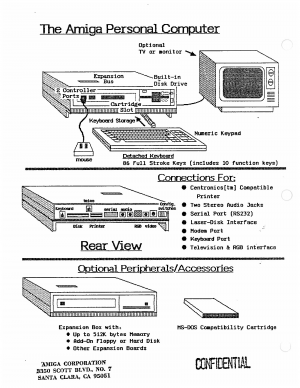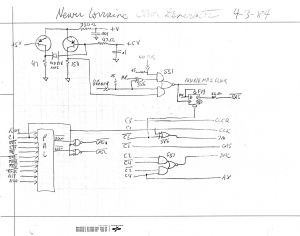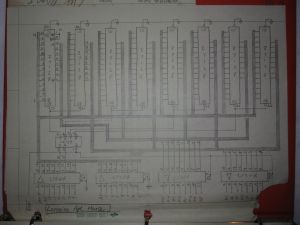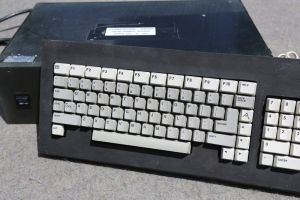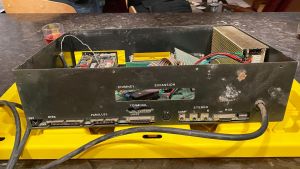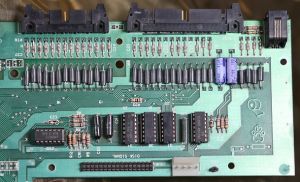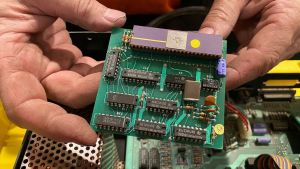Difference between revisions of "Amiga's Dark Secret"
| (127 intermediate revisions by the same user not shown) | |||
| Line 1: | Line 1: | ||
by Bernard Anderson and Chris Collins | by Bernard Anderson and Chris Collins | ||
| − | |||
| − | + | === Foreword === | |
| − | Whereas [[Jay Miner]] is the father of the Amiga, [[Dave Needle]] is the father of the A1000. He worked on several of the motherboard revisions from prototype to production. He was also there when serial number 1 of the A1000 rolled off the assembly line at the [[Sanyo]] factory in Japan. | + | Whereas [[Jay Miner]] is the father of the Amiga, [[Dave Needle]] is the father of the [[Amiga 1000|A1000]]. He worked on several of the [[motherboard]] revisions from [[prototype]] to production. He was also there when serial number 1 of the A1000 rolled off the [[assembly line]] at the [[Sanyo]] factory in [[Japan]]. |
| − | Dave | + | Dave's first assignment was converting [[Glenn Keller]]’s [[silicon]] designs to [[wire wrap]]. Soon he was working on finishing the [[Agnus]] chip, taking over for [[Joe Decuir]]. Although Dave was new to chip design, [[Jay Miner]] trained him on the spot. [https://vimeo.com/228734859 [1]] |
| − | He claimed he was a Jovian from Jupiter. | + | He claimed he was a [[Jovian]] from [[Jupiter]] who upon arriving on Earth as a child, retained all the knowledge he could remember from his previous incarnation, including the Jovian language. He also had his own customs such as a snaught pit, where he would take close friends out to lunch and pay for the meal out of generosity. [https://spectrum.ieee.org/silicon-valley-mourns-a-pioneer-in-computer-graphics-and-gaming-hardware [2]] |
| − | Dave returned to his home planet on February | + | Dave returned to his home planet on February 20th, 2016. We would like to dedicate this article in his memory. |
| − | |||
| − | |||
| − | + | [[File:Amiga Confidential.jpg|500x200px|thumb|center]] | |
| − | + | === Early Amiga === | |
| − | + | [[Amiga Corporation]] were initially known as a manufacturer of video game controllers, namely | |
| + | the [[Power Stick]] and [[Joyboard]], which were introduced in 1983. They also announced a cassette | ||
| + | based add-on for the [[Atari Incorporated|Atari]] VCS called the Power Module. These were part of their [[Power System|Power System]] product line, which was created to increase sales by tapping into an existing consumer | ||
| + | base and making contacts in the game industry. As it so happens, there was another system in | ||
| + | the works which they had been designing since the company’s inception a year earlier. [https://www.annarchive.com/files/electronic_fun_Vol_1_07_may_1983.pdf [3]] | ||
| − | + | In early 1984, word of a new computer began circulating in the press. What was initially conceived as a [[game console]] was by this point being reconfigured as a state of the art desktop [[Personal computer (PC)|PC]] called [[Lorraine]]. [[Amiga Corporation|Amiga]] were looking to compete with [[IBM]] and [[Apple]]. | |
| − | The | + | The [[computer]] would be a micro with a 320K [[IBM]] [[disk drive]], 300-baud [[modem]], four-voice stereo sound with the ability to speak in a male or female voice, and a graphics [[palette]] of 4,096 colors. 80 column [[text]] could also be displayed on a [[Television (TV)|television]] set and was reportedly so sharp, it could be read from across the room. [https://books.google.com/books?id=lC4EAAAAMBAJ&pg=PA13 [4]], [https://books.google.com/books?id=yC4EAAAAMBAJ&pg=PA41 [5]] |
| − | |||
| − | + | [[File:AmigaHardwareRef Page 034.png|thumb|center]] | |
| − | The | + | The computer would be bundled with a [[mouse]], however the hardware supported a variety of controllers available to the user: a standard [[Atari Incorporated|Atari]] [[joystick]], [[proportional controller]], [[trackball]] or [[light pen]]. And in addition to its own [[operating system]], Lorraine could run [[CP/M]] 68K or the [[UCSD p-System]]. An 8088 [[coprocessor]] [[cartridge]] for running [[MS-DOS]] was also announced. |
| − | + | A top port dubbed the [[Chimney (expansion)|chimney]] allowed an [[expansion]] box to be connected. The box would expand the memory to 512K, have [[slots]] for expansion boards and a bay for either a second [[Disk drive|floppy drive]] or [[Hard drive|hard disk]]. | |
| − | + | The expansion [[Chimney (expansion)|chimney]] is similar to that of another desktop computer being sold at the time, the [[Mindset]]. Another similarity is the support for an external video signal to be synchronized with the computer’s display. | |
| − | |||
| − | + | [[File:war_peace_9-L.jpg|thumb|center]] | |
| − | + | The original projected retail price for the [[Amiga Corporation|Amiga]] [[Lorraine]] when it first being developed in 1982 was around $200-300 USD but by this point, the figure was closer to $1,000. [[David Morse|Dave Morse]], president of [[Amiga]], assured the press and potential [[Venture Capital|investors]] that this was a real product and provided the early specifications. Morse, due to fears from [[competitors]], was careful to control how much information would be shared at the time. [[Technical Documents|Technical documents]] related to the computer remained confidential, including the [[System Memory Map|memory map]]. [https://rebellion.vhx.tv/products [11]] | |
| − | |||
| − | + | [[File:Timingbook-cropped Page 10 2.jpg|thumb|center]] | |
| + | [[File:TIMINGBOOK-1J.jpg|thumb|center]] | ||
| − | |||
| − | + | [[Dave Needle]] evaluated [[Ron Nicholson]]'s original wire-wrapped 'War' and 'Peace' motherboards for [[Lorraine]], and designed a new printed circuit board known as Lorraine PC. He included new circuits for the oscillator, clock generator as well as new CAS and RAS generators for the RAM. A new 128K ROM board he called 'Lorraine Apt. House' was also made for developers. | |
| − | |||
| − | + | The circuitry from the chip stacks were also being redesigned to make actual [[silicon]]. Ron Nicholson along with layout technicians [[Mark Shieu]] and Edwin Chu determined how many transistors would fit on each chip and made simulations using software called SPICE. | |
| + | Dave and [[Stan Shepard]] agreed to have the $15,000 they were owed in back pay go toward the fabrication. The layouts for the chips, or tape outs were sent to the fabricator in March. They got the chips back the following month. | ||
| − | + | The first batch of [[Portia]] they received had a fault which they didn’t catch in the tape out. An inverter in the disk controller wasn’t routed properly. As it had cost a considerable amount of money for the fabrication and time was tight, they couldn’t afford to scrap them. So [[Glenn Keller]] used a high powered [[microscope]] and cut through the chips with an [[X-Acto knife]]. | |
| − | + | Glenn was unsure whether to continue using this method of debugging as a number of chips were damaged in the process but was encouraged by Stan to carry on. This yielded a working [[Portia]] chip to bring to the Summer CES in Chicago. | |
| + | [https://vimeo.com/228734859 [1]], [https://archive.org/details/the_glory_years_of_amiga_part_4_of_4_with_R._J._Mical [6]] | ||
| − | + | === Amiga, Atari and Commodore === | |
| − | + | [[Atari Incorporated|Atari]], still owned by [[Warner Communications]], were interested in using the [[chipset]], initially in their [[coin-op]] division, then in a game console/stealth computer system codenamed [[Mickey]]. This project was canceled after [[Jack Tramiel]] bought Atari’s consumer division the week of July 1st. It was decided that they didn’t need another 68000 based machine. After all, they had been developing their own, the [[ST]]. | |
| + | [https://ataripodcast.libsyn.com/antic-interview-30-jerry-jessop-atari [7]], [https://www.amazon.com/Atari-Inc-Business-Curt-Vendel/dp/0985597402 [8]] | ||
| − | + | On August 15th, it was announced that [[Commodore]] had purchased the financially ailing [[Amiga]], who moved from Santa Clara to a new building in Los Gatos. By this point they were using Sun 2 workstations for software development, replacing the earlier Sage IV systems. [[Rick Geiger]] was brought in as a manager. He would later replace [[Dave Morse]] as president. [https://books.google.com/books?id=Hy8EAAAAMBAJ&pg=PA14 [9]] | |
| − | + | The [[Commodore]] purchase sparked a lawsuit from [[Atari Corporation|Atari Corp]]. This was a countersuit against [[Commodore]], claiming their former employees at the new Atari stole trade secrets when they left. It was around this time that [[Leonard Tramiel]] discovered the $500,000 check [[Atari Inc]]. had loaned [[Amiga Corporation|Amiga]]. [[David Morse|Dave Morse]] repaid the loan with interest on June 29th. Commodore had | |
| + | wired over the money. [https://news.google.com/newspapers?nid=1946&dat=19840714&id=aZEjAAAAIBAJ&sjid=kqUFAAAAIBAJ&pg=6666,1612566 [10]], [https://www.amazon.com/Atari-Inc-Business-Curt-Vendel/dp/0985597402 [8]], [https://rebellion.vhx.tv/products [11]] | ||
| + | [[File:D3-L.jpg|thumb|center]] | ||
| + | [[File:D4-L.jpg|thumb|center]] | ||
| + | [[File:Bb-back.jpg|thumb|center]] | ||
| − | + | Sometime after [[Commodore]] acquired the company, software developers were given preliminary versions of the new computer. Around 100 “[[Black Box|black box]]” [[Amiga Development System|development systems]] were handmade by Amiga, first in Santa Clara then in [[Los Gatos]]. They were housed in a black metal case and came with a black wooden keyboard. | |
| − | + | [[Commodore]] had developers purchase the development systems. However, they weren’t all | |
| + | being delivered. Frustrated with how this rollout was managed, [[Dave Needle]] personally took four of them from the hardware lab and gave them to [[Electronic Arts]]. [https://vimeo.com/228734859 [1]] | ||
| − | + | Other early software developers for the Amiga included [[Synapse]] and [[Don’t Ask Software]], who had developed the S.A.M. [[Speech synthesis|speech synthesizer]] for the [[Atari 800]], [[Apple II]] and [[Commodore 64]] computers. They received one of the first units ever made: a [[Grey Box|grey box]], serial number D-002 which featured a reset switch and a different [[motherboard]]. DAS and [[Sam Dicker]] used it for cross compiling the text to speech interface, which formed the basis for the [[Say]] command. Around 10 of the Version 1 motherboards and only 3 grey boxes were ever made. [[Don’t Ask Software]] would later change their name to SoftVoice, Inc. | |
| − | + | The Version 2 motherboards as shown in the pictures below were made using a continuous improvement process and design changes occured at a rapid pace. Development systems contained preliminary [[silicon]] which still had [[bugs]] and in some cases lacked features which were planned but not yet implemented. Some versions of the chips required modifying boards in order for them to work properly. | |
| + | [[Dave Needle]] and [[Stan Shepard]] were at the time working as contractors at Amiga. Their company was [[SHIT|Software & Hardware Innovative Technologies]] and the logo was fittingly, a toilet paper roll. Dave and Stan's logo was etched into the motherboards along with a paw print to represent [[Jay Miner]]'s dog, Mitchy. FCC testing was initially done by Dave but he would soon be too busy with PCB layout and mechanical design duties so he hired Joe Fernandez, a veteran in FCC compliance. | ||
| − | + | [[File:i-MzTsqtq-XL.jpg|thumb|center]] | |
| + | [[File:i-McD7jWC-XL cropped.jpg|thumb|center]] | ||
| − | |||
| + | === Software === | ||
| − | + | The preliminary [[operating system]] supplied with the development systems included Exec, graphics and audio libraries, device drivers and a debugger. A second computer was needed to bootstrap the machine. It booted to the debugger and instead of the display showing a hand holding a disk, the user was greeted with a solid white screen. | |
| + | As new versions of the operating system ROMs were released, some software developers began to complain that their code would no longer work, to which [[RJ Mical]] responded, "Sorry, we changed everything! We had to." It turns out the pinouts for the parallel I/O ports were also changing. Adapter boards were made to use 6526 CIA chips and finally the 8520 CIA once they became available, both replacing the original 6522 VIAs. Boxes were also adapted to use 3.5" disk drives. | ||
| − | + | Software developer [[Michael Sinz]] recalls using the [[Black Box|black box]], “You needed a [[Sun 2]] workstation - it required the [[Chimney (BillBoard)|chimney]] hardware, as the only way to get code into the Amiga was by dumping it into the RAM of the Amiga via the [[Sun 2|Sun]].” “The chimney was a really big 68000 bus extender to the Sun - and did “DMA” to the Amiga by grabbing the bus select and holding the 68000 in wait state while the Sun wrote to memory.” | |
| − | After the launch of the Amiga 1000 on July 23, 1985, the development systems were rendered obsolete and decommissioned. | + | The chimney hardware was an expansion board also known as the BillBoard, named after its designer, Bill Kolb. This was used in conjunction with a special write-protect RAM board which plugged in the cartridge slot. The BillBoard connected to an additional board installed in the Sun. |
| + | |||
| + | Debugging was done through the serial port using [[Wack]], written by [[Carl Sassenrath]]. One of its features was [[bus monitoring]]: “Wack could do some of that but it was limited by the speed of the [[Sun 2]] [[hardware]] in how much analysis it could do of the bus while it was running.” Wack would later be known as ROM-Wack, the resident debugger included with Amiga computers up until [[OS]] version 3.0. | ||
| + | |||
| + | |||
| + | === 1985 Winter CES === | ||
| + | |||
| + | One of the black boxes was shown at the 1985 Winter CES in January. As with the previous year, the Amiga was demonstrated to select attendees behind closed doors. During the show, [[Commodore]]'s West Chester engineers [[Dave Haynie]] and [[Bil Herd]] met [[RJ Mical]] and [[Dave Needle]]. When Dave mentioned he was from Jupiter, Bil joked that he and Dave Haynie were from Pluto. The two groups of engineers were getting along just fine. | ||
| + | |||
| + | That evening, the computer started malfunctioning so [[RJ Mical|RJ]] and [[Dave Needle]] disassembled it in the Amiga suite. Bil and Dave Haynie then studied the computer's circuitry and were amused to see that the Portia chip was on a riser board. At West Chester, such a board meant for working around [[bugs]] in a chip was known as a tower. They had used them while developing the C128. [https://www.amazon.com/Commodore-Amiga-Years-Brian-Bagnall/dp/0994031025 [12]], [https://hackaday.com/2015/01/10/making-the-ces-show-thirty-years-ago/ [13]], [https://www.youtube.com/watch?v=LSAD31nD3og [14]] | ||
| + | |||
| + | [[File:Portia-tower.jpg|thumb|center]] | ||
| + | |||
| + | === Conclusion === | ||
| + | |||
| + | More motherboards followed Lorraine. The next version was called [[Velvet]], and was the first to use Howard Stolz's plastic case design. Velvet was in turn followed by [[Zorro]], the board which became the basis for the production [[A1000]]. The Zorro name would later be used for the Amiga expansion bus. | ||
| + | |||
| + | After the [[World Premiere of Amiga|launch]] of the [[Amiga 1000]] on July 23, 1985, the [[Amiga Development System|development systems]] were rendered obsolete and decommissioned. | ||
| + | |||
| + | |||
| + | == References == | ||
| + | |||
| + | # Weddington, Zach, director. [https://vimeo.com/228734859 ''Viva Amiga: Further Into the Machine – Dave Needle Full Interview'']. Rock Steady Media, 2017 | ||
| + | # Spring, Adam P. [https://spectrum.ieee.org/silicon-valley-mourns-a-pioneer-in-computer-graphics-and-gaming-hardware ''Silicon Valley Mourns Amiga and Lynx co-creator Dave Needle''] - IEEE Spectrum, 3/11/2016 | ||
| + | # [https://www.annarchive.com/files/electronic_fun_Vol_1_07_may_1983.pdf ''New Products''] - Electronic Fun - vol. 1 no. 7 - 5/1983, pp. 12-13 | ||
| + | # Mace, Scott. [https://books.google.com/books?id=lC4EAAAAMBAJ&pg=PA13 ''Amiga Plans Release of High-End Home Micro''] - InfoWorld, vol. 6, no. 13 - 3/26/1984, p. 13. Google Books | ||
| + | # Mace, Scott. [https://books.google.com/books?id=yC4EAAAAMBAJ&pg=PA41 ''Amiga Demos Its New Machine''] - InfoWorld, vol. 6, no. 28 - 7/9/1984, pp. 41-42. Google Books | ||
| + | # Mical, RJ. [https://archive.org/details/the_glory_years_of_amiga_part_4_of_4_with_R._J._Mical ''The Glory Years of Amiga'' (Part 4)] - AmiExpo 1988 | ||
| + | # Savetz, Kay. [https://ataripodcast.libsyn.com/antic-interview-30-jerry-jessop-atari ''ANTIC Interview 30 - Jerry Jessop''] - ANTIC The Atari 8-bit Podcast, 8 April 2015. Accessed 5 May 2022 | ||
| + | # Goldberg, Marty and Vendel, Curt - [https://www.amazon.com/Atari-Inc-Business-Curt-Vendel/dp/0985597402 ''Atari Inc.: Business Is Fun''] - Syzygy Co. Press/[https://theatarimuseum.com Atari Museum] - 2012 | ||
| + | # Mace, Scott. [https://books.google.com/books?id=Hy8EAAAAMBAJ&pg=PA14 ''Commodore Buys Amiga''] - InfoWorld, vol. 6 no. 37 - 9/10/1984, p. 14. Google Books | ||
| + | # [https://news.google.com/newspapers?nid=1946&dat=19840714&id=aZEjAAAAIBAJ&sjid=kqUFAAAAIBAJ&pg=6666,1612566 ''Injunction Extended Against Atari Employees''] - Montreal Gazette (AP) - 7/14/1984, p. 73 (G-3). Google News | ||
| + | # Caufield, Nicola and Anthony, directors. [https://rebellion.vhx.tv/products ''From Bedrooms to Billions: The Amiga Years'']. Rebellion, 2015 | ||
| + | # Bagnall, Brian. [https://www.amazon.com/Commodore-Amiga-Years-Brian-Bagnall/dp/0994031025 ''Commodore: The Amiga Years''] Variant Press - 2017 | ||
| + | # Herd, Bil. [https://hackaday.com/2015/01/10/making-the-ces-show-thirty-years-ago/ ''Making the CES Show... Thirty Years Ago''] - Additional comments by Dave Haynie - Hackaday 1/10-11/2015 | ||
| + | # [https://www.youtube.com/watch?v=LSAD31nD3og ''The Acquisition of Amiga From Commodore's Perspective & Custom Chips w/ Dave Haynie and Andy Finkel''] - The Guru Meditation - Filmed 4/22/2022 | ||
Latest revision as of 19:37, 28 October 2023
by Bernard Anderson and Chris Collins
Contents
Foreword
Whereas Jay Miner is the father of the Amiga, Dave Needle is the father of the A1000. He worked on several of the motherboard revisions from prototype to production. He was also there when serial number 1 of the A1000 rolled off the assembly line at the Sanyo factory in Japan.
Dave's first assignment was converting Glenn Keller’s silicon designs to wire wrap. Soon he was working on finishing the Agnus chip, taking over for Joe Decuir. Although Dave was new to chip design, Jay Miner trained him on the spot. [1]
He claimed he was a Jovian from Jupiter who upon arriving on Earth as a child, retained all the knowledge he could remember from his previous incarnation, including the Jovian language. He also had his own customs such as a snaught pit, where he would take close friends out to lunch and pay for the meal out of generosity. [2]
Dave returned to his home planet on February 20th, 2016. We would like to dedicate this article in his memory.
Early Amiga
Amiga Corporation were initially known as a manufacturer of video game controllers, namely the Power Stick and Joyboard, which were introduced in 1983. They also announced a cassette based add-on for the Atari VCS called the Power Module. These were part of their Power System product line, which was created to increase sales by tapping into an existing consumer base and making contacts in the game industry. As it so happens, there was another system in the works which they had been designing since the company’s inception a year earlier. [3]
In early 1984, word of a new computer began circulating in the press. What was initially conceived as a game console was by this point being reconfigured as a state of the art desktop PC called Lorraine. Amiga were looking to compete with IBM and Apple.
The computer would be a micro with a 320K IBM disk drive, 300-baud modem, four-voice stereo sound with the ability to speak in a male or female voice, and a graphics palette of 4,096 colors. 80 column text could also be displayed on a television set and was reportedly so sharp, it could be read from across the room. [4], [5]
The computer would be bundled with a mouse, however the hardware supported a variety of controllers available to the user: a standard Atari joystick, proportional controller, trackball or light pen. And in addition to its own operating system, Lorraine could run CP/M 68K or the UCSD p-System. An 8088 coprocessor cartridge for running MS-DOS was also announced.
A top port dubbed the chimney allowed an expansion box to be connected. The box would expand the memory to 512K, have slots for expansion boards and a bay for either a second floppy drive or hard disk.
The expansion chimney is similar to that of another desktop computer being sold at the time, the Mindset. Another similarity is the support for an external video signal to be synchronized with the computer’s display.
The original projected retail price for the Amiga Lorraine when it first being developed in 1982 was around $200-300 USD but by this point, the figure was closer to $1,000. Dave Morse, president of Amiga, assured the press and potential investors that this was a real product and provided the early specifications. Morse, due to fears from competitors, was careful to control how much information would be shared at the time. Technical documents related to the computer remained confidential, including the memory map. [11]
Dave Needle evaluated Ron Nicholson's original wire-wrapped 'War' and 'Peace' motherboards for Lorraine, and designed a new printed circuit board known as Lorraine PC. He included new circuits for the oscillator, clock generator as well as new CAS and RAS generators for the RAM. A new 128K ROM board he called 'Lorraine Apt. House' was also made for developers.
The circuitry from the chip stacks were also being redesigned to make actual silicon. Ron Nicholson along with layout technicians Mark Shieu and Edwin Chu determined how many transistors would fit on each chip and made simulations using software called SPICE.
Dave and Stan Shepard agreed to have the $15,000 they were owed in back pay go toward the fabrication. The layouts for the chips, or tape outs were sent to the fabricator in March. They got the chips back the following month.
The first batch of Portia they received had a fault which they didn’t catch in the tape out. An inverter in the disk controller wasn’t routed properly. As it had cost a considerable amount of money for the fabrication and time was tight, they couldn’t afford to scrap them. So Glenn Keller used a high powered microscope and cut through the chips with an X-Acto knife.
Glenn was unsure whether to continue using this method of debugging as a number of chips were damaged in the process but was encouraged by Stan to carry on. This yielded a working Portia chip to bring to the Summer CES in Chicago. [1], [6]
Amiga, Atari and Commodore
Atari, still owned by Warner Communications, were interested in using the chipset, initially in their coin-op division, then in a game console/stealth computer system codenamed Mickey. This project was canceled after Jack Tramiel bought Atari’s consumer division the week of July 1st. It was decided that they didn’t need another 68000 based machine. After all, they had been developing their own, the ST. [7], [8]
On August 15th, it was announced that Commodore had purchased the financially ailing Amiga, who moved from Santa Clara to a new building in Los Gatos. By this point they were using Sun 2 workstations for software development, replacing the earlier Sage IV systems. Rick Geiger was brought in as a manager. He would later replace Dave Morse as president. [9]
The Commodore purchase sparked a lawsuit from Atari Corp. This was a countersuit against Commodore, claiming their former employees at the new Atari stole trade secrets when they left. It was around this time that Leonard Tramiel discovered the $500,000 check Atari Inc. had loaned Amiga. Dave Morse repaid the loan with interest on June 29th. Commodore had wired over the money. [10], [8], [11]
Sometime after Commodore acquired the company, software developers were given preliminary versions of the new computer. Around 100 “black box” development systems were handmade by Amiga, first in Santa Clara then in Los Gatos. They were housed in a black metal case and came with a black wooden keyboard.
Commodore had developers purchase the development systems. However, they weren’t all being delivered. Frustrated with how this rollout was managed, Dave Needle personally took four of them from the hardware lab and gave them to Electronic Arts. [1]
Other early software developers for the Amiga included Synapse and Don’t Ask Software, who had developed the S.A.M. speech synthesizer for the Atari 800, Apple II and Commodore 64 computers. They received one of the first units ever made: a grey box, serial number D-002 which featured a reset switch and a different motherboard. DAS and Sam Dicker used it for cross compiling the text to speech interface, which formed the basis for the Say command. Around 10 of the Version 1 motherboards and only 3 grey boxes were ever made. Don’t Ask Software would later change their name to SoftVoice, Inc.
The Version 2 motherboards as shown in the pictures below were made using a continuous improvement process and design changes occured at a rapid pace. Development systems contained preliminary silicon which still had bugs and in some cases lacked features which were planned but not yet implemented. Some versions of the chips required modifying boards in order for them to work properly.
Dave Needle and Stan Shepard were at the time working as contractors at Amiga. Their company was Software & Hardware Innovative Technologies and the logo was fittingly, a toilet paper roll. Dave and Stan's logo was etched into the motherboards along with a paw print to represent Jay Miner's dog, Mitchy. FCC testing was initially done by Dave but he would soon be too busy with PCB layout and mechanical design duties so he hired Joe Fernandez, a veteran in FCC compliance.
Software
The preliminary operating system supplied with the development systems included Exec, graphics and audio libraries, device drivers and a debugger. A second computer was needed to bootstrap the machine. It booted to the debugger and instead of the display showing a hand holding a disk, the user was greeted with a solid white screen.
As new versions of the operating system ROMs were released, some software developers began to complain that their code would no longer work, to which RJ Mical responded, "Sorry, we changed everything! We had to." It turns out the pinouts for the parallel I/O ports were also changing. Adapter boards were made to use 6526 CIA chips and finally the 8520 CIA once they became available, both replacing the original 6522 VIAs. Boxes were also adapted to use 3.5" disk drives.
Software developer Michael Sinz recalls using the black box, “You needed a Sun 2 workstation - it required the chimney hardware, as the only way to get code into the Amiga was by dumping it into the RAM of the Amiga via the Sun.” “The chimney was a really big 68000 bus extender to the Sun - and did “DMA” to the Amiga by grabbing the bus select and holding the 68000 in wait state while the Sun wrote to memory.”
The chimney hardware was an expansion board also known as the BillBoard, named after its designer, Bill Kolb. This was used in conjunction with a special write-protect RAM board which plugged in the cartridge slot. The BillBoard connected to an additional board installed in the Sun.
Debugging was done through the serial port using Wack, written by Carl Sassenrath. One of its features was bus monitoring: “Wack could do some of that but it was limited by the speed of the Sun 2 hardware in how much analysis it could do of the bus while it was running.” Wack would later be known as ROM-Wack, the resident debugger included with Amiga computers up until OS version 3.0.
1985 Winter CES
One of the black boxes was shown at the 1985 Winter CES in January. As with the previous year, the Amiga was demonstrated to select attendees behind closed doors. During the show, Commodore's West Chester engineers Dave Haynie and Bil Herd met RJ Mical and Dave Needle. When Dave mentioned he was from Jupiter, Bil joked that he and Dave Haynie were from Pluto. The two groups of engineers were getting along just fine.
That evening, the computer started malfunctioning so RJ and Dave Needle disassembled it in the Amiga suite. Bil and Dave Haynie then studied the computer's circuitry and were amused to see that the Portia chip was on a riser board. At West Chester, such a board meant for working around bugs in a chip was known as a tower. They had used them while developing the C128. [12], [13], [14]
Conclusion
More motherboards followed Lorraine. The next version was called Velvet, and was the first to use Howard Stolz's plastic case design. Velvet was in turn followed by Zorro, the board which became the basis for the production A1000. The Zorro name would later be used for the Amiga expansion bus.
After the launch of the Amiga 1000 on July 23, 1985, the development systems were rendered obsolete and decommissioned.
References
- Weddington, Zach, director. Viva Amiga: Further Into the Machine – Dave Needle Full Interview. Rock Steady Media, 2017
- Spring, Adam P. Silicon Valley Mourns Amiga and Lynx co-creator Dave Needle - IEEE Spectrum, 3/11/2016
- New Products - Electronic Fun - vol. 1 no. 7 - 5/1983, pp. 12-13
- Mace, Scott. Amiga Plans Release of High-End Home Micro - InfoWorld, vol. 6, no. 13 - 3/26/1984, p. 13. Google Books
- Mace, Scott. Amiga Demos Its New Machine - InfoWorld, vol. 6, no. 28 - 7/9/1984, pp. 41-42. Google Books
- Mical, RJ. The Glory Years of Amiga (Part 4) - AmiExpo 1988
- Savetz, Kay. ANTIC Interview 30 - Jerry Jessop - ANTIC The Atari 8-bit Podcast, 8 April 2015. Accessed 5 May 2022
- Goldberg, Marty and Vendel, Curt - Atari Inc.: Business Is Fun - Syzygy Co. Press/Atari Museum - 2012
- Mace, Scott. Commodore Buys Amiga - InfoWorld, vol. 6 no. 37 - 9/10/1984, p. 14. Google Books
- Injunction Extended Against Atari Employees - Montreal Gazette (AP) - 7/14/1984, p. 73 (G-3). Google News
- Caufield, Nicola and Anthony, directors. From Bedrooms to Billions: The Amiga Years. Rebellion, 2015
- Bagnall, Brian. Commodore: The Amiga Years Variant Press - 2017
- Herd, Bil. Making the CES Show... Thirty Years Ago - Additional comments by Dave Haynie - Hackaday 1/10-11/2015
- The Acquisition of Amiga From Commodore's Perspective & Custom Chips w/ Dave Haynie and Andy Finkel - The Guru Meditation - Filmed 4/22/2022

